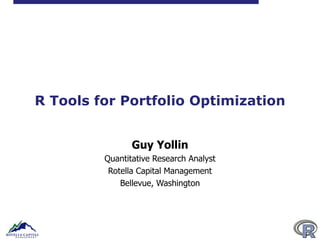
R/Finance 2009 Chicago
- 1. R Tools for Portfolio Optimization Guy Yollin Quantitative Research Analyst Rotella Capital Management Bellevue, Washington
- 3. Introduction R-SIG-FINANCE QUESTION: Can I do < fill in the blank > portfolio optimization in R? ANSWER: Yes! (98% confidence level)
- 7. Efficient Frontier efficient frontier with shorts efficient frontier long only
- 8. Efficient Frontier Calculation effFrontier = function (averet, rcov, nports = 20, shorts=T, wmax=1) { mxret = max(abs(averet)) mnret = -mxret n.assets = ncol(averet) reshigh = rep(wmax,n.assets) if( shorts ) { reslow = rep(-wmax,n.assets) } else { reslow = rep(0,n.assets) } min.rets = seq(mnret, mxret, len = nports) vol = rep(NA, nports) ret = rep(NA, nports) for (k in 1:nports) { port.sol = NULL try(port.sol <- portfolio.optim(x=averet, pm=min.rets[k], covmat=rcov, reshigh=reshigh, reslow=reslow,shorts=shorts),silent=T) if ( !is.null(port.sol) ) { vol[k] = sqrt(as.vector(port.sol$pw %*% rcov %*% port.sol$pw)) ret[k] = averet %*% port.sol$pw } } return(list(vol = vol, ret = ret)) } wrapped in try to handle unfeasible optimizations
- 10. Maximum Sharpe Ratio callback function calls portfolio.optim() use optimize() to find return level with maximum Sharpe ratio maxSharpe = function (averet, rcov, shorts=T, wmax = 1) { optim.callback = function(param,averet,rcov,reshigh,reslow,shorts) { port.sol = NULL try(port.sol <- portfolio.optim(x=averet, pm=param, covmat=rcov, reshigh=reshigh, reslow=reslow, shorts=shorts), silent = T) if (is.null(port.sol)) { ratio = 10^9 } else { m.return = averet %*% port.sol$pw m.risk = sqrt(as.vector(port.sol$pw %*% rcov %*% port.sol$pw)) ratio = -m.return/m.risk assign("w",port.sol$pw,inherits=T) } return(ratio) } ef = effFrontier(averet=averet, rcov=rcov, shorts=shorts, wmax=wmax, nports = 100) n = ncol(averet) reshigh = rep(wmax,n) if( shorts ) { reslow = -reshigh } else { reslow = rep(0,n) } max.sh = which.max(ef$ret/ef$vol) w = rep(0,ncol(averet)) xmin = optimize(f=optim.callback, interval=c(ef$ret[max.sh-1], upper=ef$ret[max.sh+1]), averet=averet,rcov=rcov,reshigh=reshigh,reslow=reslow,shorts=shorts) return(w) }
- 14. Conditional Value-at-Risk mean of worst 1- losses is our confidence level (e.g. 95% or 90%)
- 17. CVaR Optimization cvarOpt = function(rmat, alpha=0.05, rmin=0, wmin=0, wmax=1, weight.sum=1) { require(Rglpk) n = ncol(rmat) # number of assets s = nrow(rmat) # number of scenarios i.e. periods averet = colMeans(rmat) # creat objective vector, constraint matrix, constraint rhs Amat = rbind(cbind(rbind(1,averet),matrix(data=0,nrow=2,ncol=s+1)), cbind(rmat,diag(s),1)) objL = c(rep(0,n), rep(-1/(alpha*s), s), -1) bvec = c(weight.sum,rmin,rep(0,s)) # direction vector dir.vec = c("==",">=",rep(">=",s)) # bounds on weights bounds = list(lower = list(ind = 1:n, val = rep(wmin,n)), upper = list(ind = 1:n, val = rep(wmax,n))) res = Rglpk_solve_LP(obj=objL, mat=Amat, dir=dir.vec, rhs=bvec, types=rep("C",length(objL)), max=T, bounds=bounds) w = as.numeric(res$solution[1:n]) return(list(w=w,status=res$status)) } supports general equality/inequality constraints
- 18. CVaR Efficient Frontier maximum CVaR ratio minimum CVaR Note: some assets not displayed due to cropping
- 21. Differential Evolution Algorithm see http://www.icsi.berkeley.edu/~storn/code.html CR
- 22. DE Example global minimum at (1,1)
- 26. Omega Optimization optOmega = function(x,ret,L) { retu = ret %*% x obj = -Omega(retu,L=L,method="simple") weight.penalty = 100*(1-sum(x))^2 return( obj + weight.penalty ) } > lower = rep(0,n.assets) > upper = rep(wmax,n.assets) > res = DEoptim(optOmega,lower,upper, control=list(NP=2000,itermax=1000,F=0.2,CR=0.8), ret=coredata(r),L=L) > w = cleanWeights(res$optim$bestmem,syms) > w[w!=0] AXP BA C CAT CVX DD DIS GE GM HD IBM INTC JNJ KO MCD MMM 0.02 0.03 0.02 0.04 0.05 0.08 0.01 0.02 0.01 0.03 0.04 0.09 0.05 0.08 0.05 0.04 MRK PG T UTX VZ WMT XOM 0.04 0.10 0.08 0.04 0.06 0.03 0.00 objective function calls Omega() from PerformanceAnalytics
- 27. Effect of DE Parameters on Optimization
- 28. Max Omega versus Max Sharpe Max Sharpe Sharpe = 6.76 Omega = 3.07 Max Omega Omega = 3.50 Sharpe = 5.92 Note: some assets not displayed due to cropping
- 30. Optimization with Additional Constraints # max omega with non-zero weights between 3% & 10% optOmega.gt3 = function(x,ret,L) { retu = ret %*% x obj = -Omega(retu,L=L,method="simple") weight.penalty = 100*(1-sum(x))^2 small.weight.penalty = 100*sum(x[x<0.03]) return( obj + weight.penalty + small.weight.penalty ) } res = DEoptim(optOmega.gt3,lower,upper, control=list(NP=2000,itermax=1000,F=0.2,CR=0.8), ret=coredata(r),L=L) all non-zero weights now greater than 3%
- 31. Maximum Drawdown
- 32. Maximum Drawdown Optimization # max drawdown with non-zero weights between 3% & 10% optMDD.gt3 = function(x,ret) { retu = ret %*% x obj = mddx(retu,1) weight.penalty = 100*(1-sum(x))^2 small.weight.penalty = 100*sum(x[x<0.03]) return( obj + weight.penalty + small.weight.penalty ) } res = DEoptim(optMDD.gt3,lower,upper, control=list(NP=2000,itermax=1000,F=0.2,CR=0.8), ret=coredata(r)) function return the mean of the top n drawdowns (in this case n=1) could readily implement optimization on Calmar or Sterling ratios
- 33. Maximum Drawdown Optimization MaxDD = 0.47% MaxDD = 1.85% MaxDD = 0.98%
- 35. R-Ratio Optimization optRR.gt3 = function(x,ret) { retu = ret %*% x obj = -CVaR(-retu)/CVaR(retu) weight.penalty = 100*(1-sum(x))^2 small.weight.penalty = 100*sum(x[x<0.03]) return( obj + weight.penalty + small.weight.penalty ) } res = DEoptim(optRR.gt3,lower,upper, control=list(NP=2000,itermax=1000,F=0.2,CR=0.8), ret=coredata(r))
- 36. R-Ratio Comparison R-Ratio = 2.6 R-Ratio = 1.7 R-Ratio = 1.9 R-Ratio = 2.1